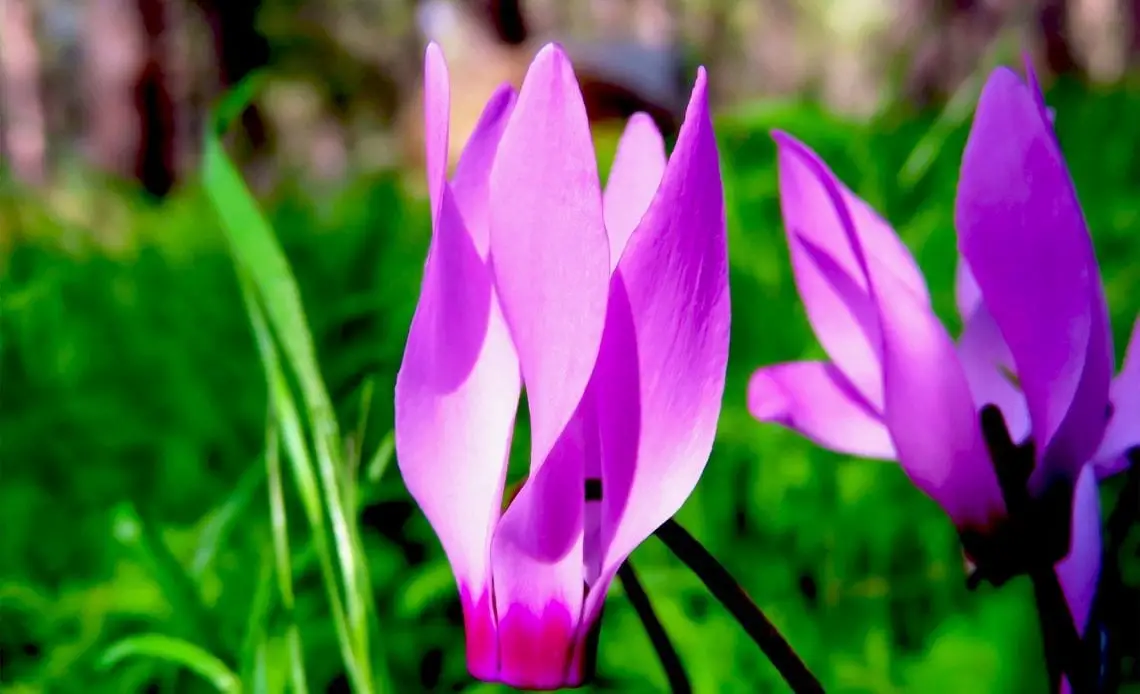
Last updated on May 20th, 2023 at 10:06 pm
Cyclamen are perennial plants in the family Primulaceae. The genus cyclamen has over twenty species with wide geographic distribution. While most cyclamens are primarily spread across the Mediterranean region, several species are native to Europe, parts of the Middle East, and Asia (Turkey, Lebanon, Israel, Palestine, Syria, and Iran). Only one species, Cyclamen somalense, is found in Africa, thriving in the Al Mishkat Mountains of Northeast Somalia.
The cyclamen flowers are small (1-2 cm) and grow on leafless stems 15-30 cm tall. The flower petals are twisted and reflexed (upswept), giving the flower its distinctive appearance of a graceful bent. This evolutionary feature protects the pollen from rain. The color of the cyclamen flower can be white, pink, lavender, or red, with a darker ring at the center. The foliage consists of thick, succulent, heart-shaped, and dark-green leaves, marked with silver-gray patterns and often purple underside.
Cyclamen flowers bloom from December to April, with a peak in February. An autumn variety of cyclamen (var. autumnale) blooms during the dry part of the autumn.
The origin of the word cyclamen is the Greek word kyklos, meaning a circle, ring, or globe, and its derivative kyklamenos, meaning circular. This refers to the round shape of the flower’s opening and the bulb-like underground tuber (the thickened underground part of the rhizome).
Some old English folk names for wild cyclamen are sowbread, swinebread, pig turnip, and stag truffle. This naming is from the observation that wild pigs often dug out and ate the plant’s tuberous roots.
In the Middle East, the cyclamen is also called ‘soap of the shepherds’ because shepherds often use the saponin contained in the cyclamen tuber as a natural detergent that removes clothing stains.
What does the Cyclamen flower symbolize?
Cyclamen flowers have rich lore in many cultures. Spiritually, they are perceived as a symbol of devotion, sincere heart, and empathy. They are often planted in churchyards and near Christian and Islamic monasteries (ribats) in the Mediterranean.
The bent cyclamen flower symbolizes modesty, humility, and reverence in Christianity. For this reason, the cyclamen is compared to the graceful humbleness of the Virgin Mary at the time of her immaculate conception. The flower’s bent is later compared to her grief over the body of the crucified Jesus, while the cyclamen heart-shaped leaf symbolizes her aching heart. Also known as ‘Incense of the Virgin Mary’ and ‘bleeding nun,’ cyclamen flowers are sometimes used to decorate chapels and statues of Mary. Cyclamen incense was also used in churches dedicated to Mary. One of the common Arabic names for cyclamen is Bakhur Miriam or Mary’s incense.
A beautiful Jewish legend tells that the Biblical King Solomon searched for the perfect design for his royal crown. For seven days, his royal servants traveled far and wide, trying to find inspiration in the land’s flora. Whichever flower they would look at had some imperfection, either as a thorn, bad smell, or unfit patterns.
Despondent at their failure to find the perfect flower, they noticed cyclamen flowers under a mountain rock on their way back to Jerusalem. They immediately loved the flower, as did Solomon, when they presented their choice to him. The wise King Solomon described cyclamen as enchanting yet bent in humility before God. He compared its petals to the gazelle’s horns, the symbol of the Children of Israel.
His golden crown was adorned with jewels in the shape of cyclamen, and he carried it for forty years. When Solomon died, everyone mourned, yet the grief of the cyclamens was unsurpassed. Centuries later, the sorrowful cyclamen flowers bent their heads further down after the King of Babylon conquered Jerusalem and destroyed the Temple. They have remained bent ever since.
In a slightly different version of the legend, Israel’s best artists and craftsmen came forward with their crown designs for King Solomon. Not like any of them, King Solomon himself searched the mountains for the perfect floral design. Many flowers competed for his attention, but he did not like their arrogance and disdain. When he finally spotted the modest cyclamen under a rock, he knew they were a perfect choice. They reminded him of the two traits of a good ruler—wisdom and modesty.
In tribute to King Solomon, the cyclamen flower is known under the Hebrew name Netzer Shlomo (Crown of King Solomon).
Cyclamen was first introduced to China from Europe in 1920. The Chinese writer Zhou Shoujuan was the first to note the resemblance of the cyclamen flower to upturned rabbit ears.
A Chinese fairy tale tells the story of the origin of the cyclamen flower. Chang’e stole an elixir of immortality from her husband Hou Yi and then escaped to the Moon, becoming known as the Goddess of the Moon. The jade rabbit was her faithful companion.
Chang’e, dearly missing her family, one day decided to pay a visit to Hou Yi. The jade rabbit, giving them privacy, chose to play in the garden. There he met a gardener and grew very fond of him. When it was time to return to the Moon, the jade rabbit took a flower seed from his ear and gifted it to the gardener.
This seed sprouted into a cyclamen flower whose petals resemble the ears of a rabbit. Cyclamen is also called the ‘bunny-ear flower’ in the Far East.
Since antiquity, cyclamen has been considered a romantic medicine. The Greek physician, botanist, and pharmacologist Pedanius Dioscorides mentioned cyclamen as an aphrodisiac. For this reason, the plant biologist Theophrastus, a successor to Aristotle, wrote that the cyclamen symbolized sensuality and lust.
Cakes made of baked cyclamen tubers were consumed as a love potion. Cyclamen oil is considered a magical cure for a broken heart.
All in all, the cyclamen flower symbolic meanings are:
- love
- sincere tenderness
- purity
- innocence
- perfection
- elegance
- devotion
- empathy
Meaning of the Cyclamen flower colors
White color
White cyclamen flowers often have a prominent red circle at their opening. For this reason, they symbolically represent Mary’s sorrow (bleeding heart) during the crucifixion of Jesus on the cross. Another meaning of white cyclamen is innocence and purity.
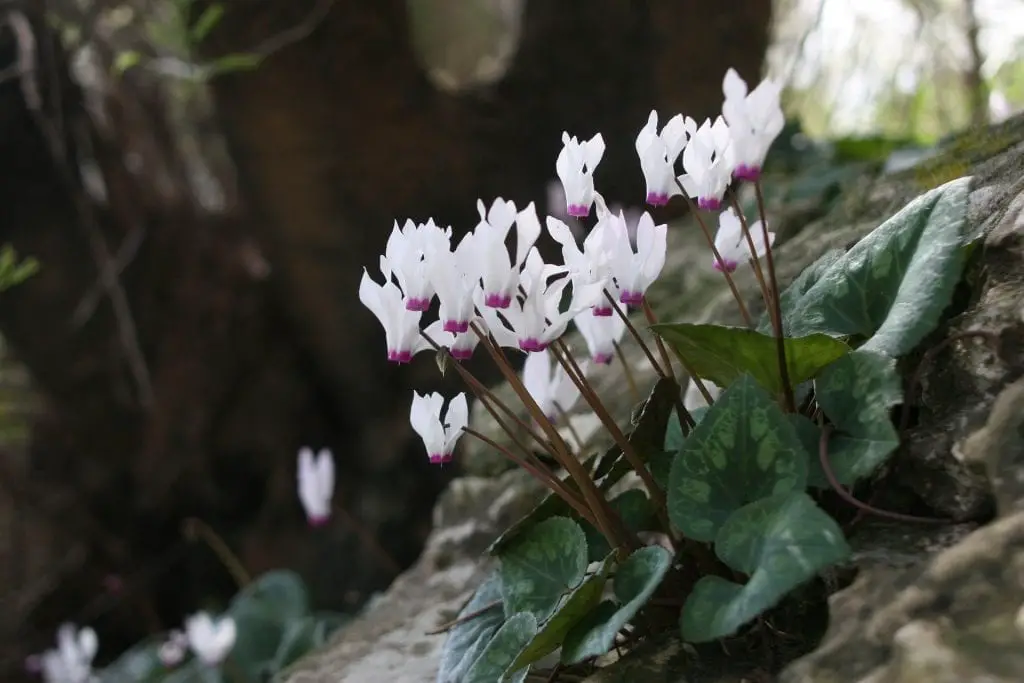
Pink color
The pink cyclamen flower represents a shy, modest and introverted personality. They support and strengthen one’s self-confidence, especially in times of uncertainty and adversity.
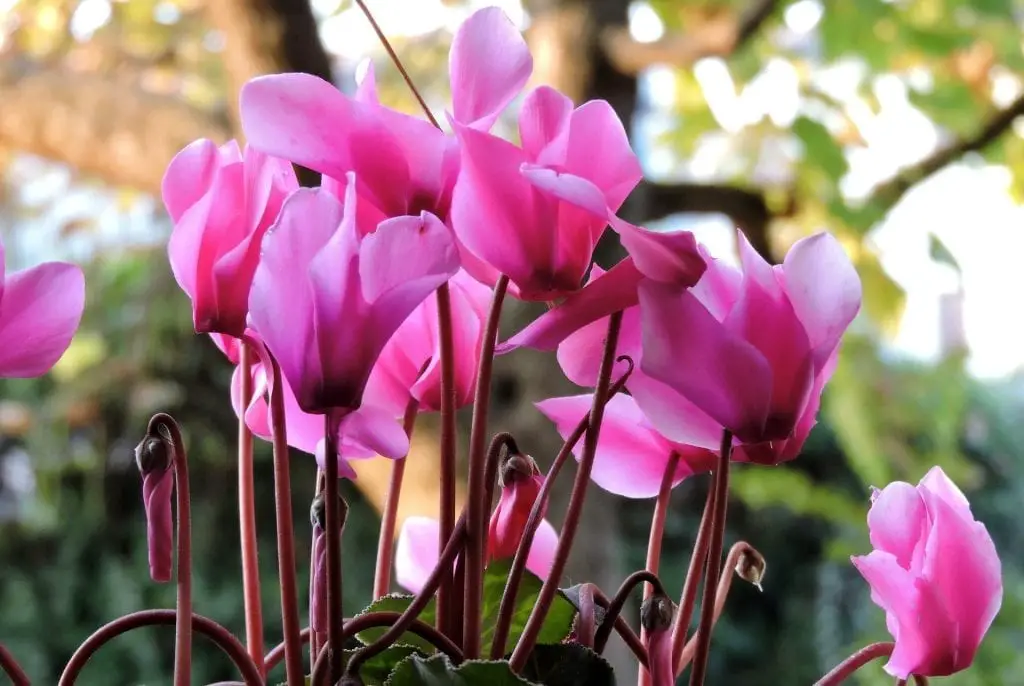
Red color
The red cyclamen flower derives some of its meaning from the intensity of its color—they stand for romantic affection and love.
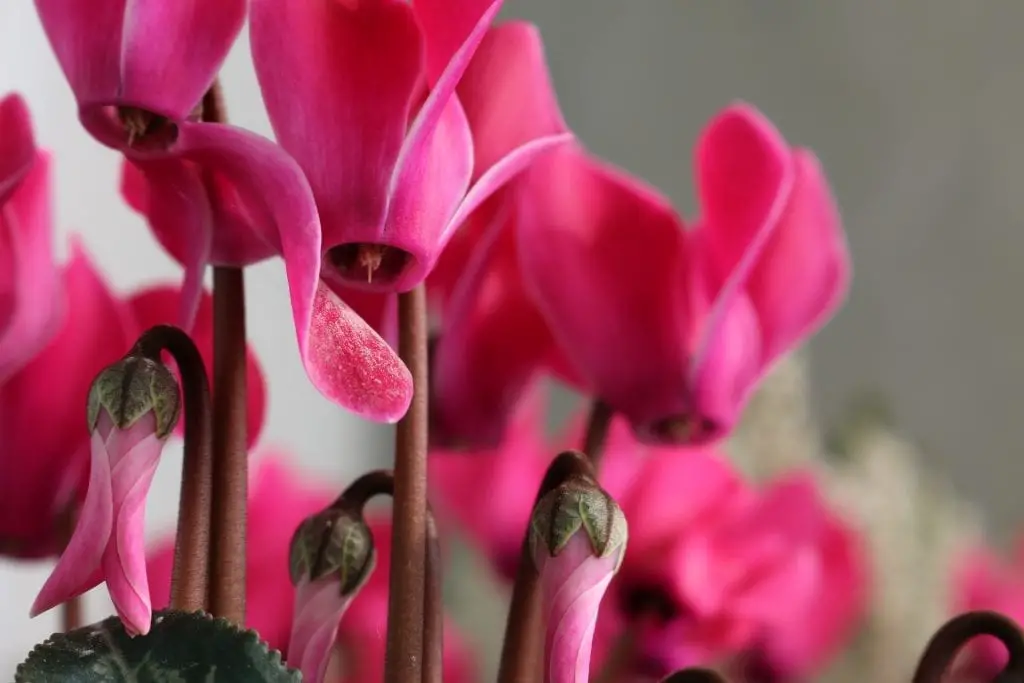
Purple color
Purple cyclamen flowers represent diffidence, distrust, resignation, separation, parting, and lost love. Some of these negative meanings are due to the plant’s toxicity.
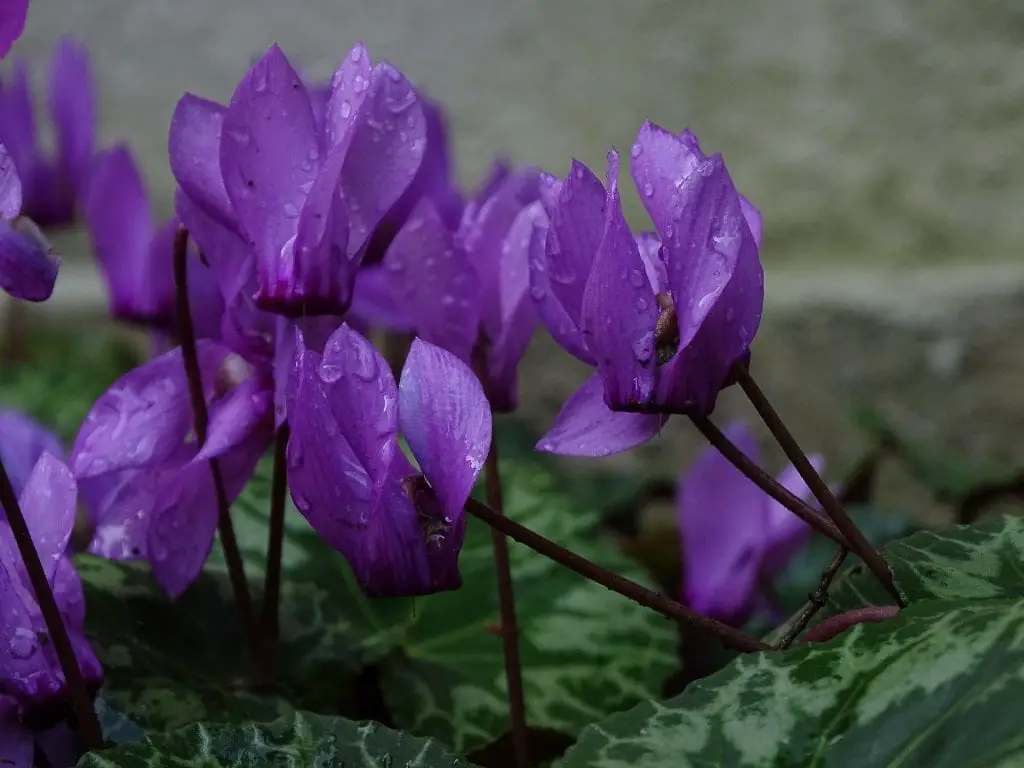
Interesting facts about the Cyclamen flowers
- Certain cyclamen varieties are resilient to temperatures as low as -10 degrees Celsius.
- When the flowering is over, the stalk spirals, bringing the fruit and the seeds close to the ground.
- Wild cyclamen are considered endangered in several countries under the multilateral CITES treaty.
- In the sixteenth century, Turkish Sultans used cyclamen as a chief ingredient to prepare a special incense that burned inside the Topkapi Palace.
- Tiny moths pollinate cyclamen flowers without proboscises (elongated feeding tubes attached to the head). When they enter the flower to eat the pollen, some of the pollen sticks to their bodies and gets carried to other flowers.
- The leaf pattern is unique to the cyclamen, with no two plants having identical silver-gray markings on the top of their leaves.
- Cyclamen reached their peak popularity in sixteenth-century England, where they were cultivated in the gardens of Queen Elizabeth I.
- During the Renaissance, cyclamen leaves were a popular herbal medicine ingredient. They were used to treat sores and boils, as well as to relieve earaches. This, however, is a common application of cyclamen in traditional medicine. A quirky English traditional belief led people to put cyclamen flowers inside their nostrils, convinced that this was an effective cure for baldness.
- Cyclamen is a culinary specialty among Arab people. The dish is made of cooked cyclamen leaves wrapped around meat and rice balls.
- Leonardo da Vinci was very fond of cyclamen flowers. He drew them at the margins of his manuscripts.
- Cyclamen have been used as a traditional remedy against snakebites.
- Cyclamen are toxic to cats and dogs.
- Cyclamen is the national flower of Israel and Cyprus.
- Meghan Markle’s wedding veil was embellished with the flora of the 53 Commonwealth countries. Cyclamen Cyprium, the endemic cyclamen species of Cyprus, was also featured on the veil embellishment.
How to grow Cyclamen flowers
Cyclamens are very durable. You can grow them indoors or outside and enjoy them inside your home or garden.
- Plant the cyclamens in well-drained soil with a slightly acidic soil pH.
- Grow them into a loam-based compost with added grit and a handful of peat.
- Place them in a spot that gets bright indirect light but not much direct sunlight.
- Allow soil to dry between waterings, do not overwater.
- Feed the plant with general-purpose plant food fall-spring.
How to care for Cyclamen flowers
- Water the cyclamens whenever the soil feels dry about an inch below its surface.
- Feed the plant with a diluted liquid low-nitrogen fertilizer every couple of weeks while in full leaf.
- Remove yellowing, dead leaves as they appear.
- Pluck off fading flowers and seed heads to extend the blooming period.
Best time to gift Cyclamen flowers
The diverse symbology and folklore related to cyclamen often produce contradictory meanings and messages. Cyclamen can mean love or resignation, fertility or death, good luck or goodbye. Before gifting someone cyclamen flowers, it is wise to consider the context of the situation and the sensibility of the recipient. Fortunately, a gift of these flowers is mostly seen as an expression of sincere feelings.
Cyclamen flowers are believed to ward off evil forces and bring good luck. Cyclamens bring back harmony and stabilize the vibe in a home where the family members have become alienated. This also applies to extended family homes, where cross-generational misunderstandings and conflict create long-term tension. This makes cyclamen flowers a perfect housewarming gift. When gifted to another family member, a pot of cyclamen flowers becomes an expression of kindness and support.
According to a traditional belief from Central and Southern Europe, cyclamen flowers give hope and strength to the desperate and uplift the spirit. These flowers are a perfect encouragement gift to someone going through a difficult phase in life or struggling to overcome stress and depression.
Traditionally, the cyclamen is a popular fertility symbol since the flower’s shape resembles the uterus. People used them as herbal amulets that promoted conception. A gift of cyclamen flowers is a nice way to celebrate the arrival of a baby in the family. It was once believed that keeping cyclamen on a pregnant woman’s neck could ease childbirth. A contrary folk belief states that if a pregnant woman wears a cyclamen root or accidentally steps on cyclamen flowers, the child will be born prematurely.
Some sources consider purple cyclamen a flower of goodbyes. Potted purple cyclamen can be gifted to friends and colleagues who are moving to another place, changing jobs, or retiring.
Cyclamen varieties that bloom in autumn are often associated with All Saint’s Day. On that occasion, cyclamen flowers are placed on tombs, altars, and burial grounds, to honor the dead.
Cyclamen flowers are rarely exchanged between lovers because it is often seen as a symbol of separation. Red cyclamen could be an exception to this rule.
Conclusion
Cyclamens are attractive small flowers with butterfly-like blossoms that create a sense of movement. They brighten the home and breathe life into the dreary winter days as houseplants. They frequently add a splash of color to the garden during the fall and winter when few other flowers bloom.
Cyclamen plants in pots are an ideal gift for almost everyone on your list. These flowers are perfect for mothers, daughters, sisters, and perhaps your new love interest. Cyclamen from a florist makes fantastic holiday gifts and can even be used as hostess gifts. The flowers bloom for several months, adding winter color to the cold, gloomy days.
Consider cyclamen flowers as a quick pick-me-up throughout the winter or to commemorate significant occasions such as birthdays and promotions. Cyclamens are an excellent bedside plant for recovering from illness or for consoling and motivating housebound people.
If you want to know and learn more about flowers, we at PansyMaiden can help you. Check out our fun, easy-to-read, and informative flower-related content that you will surely enjoy!
